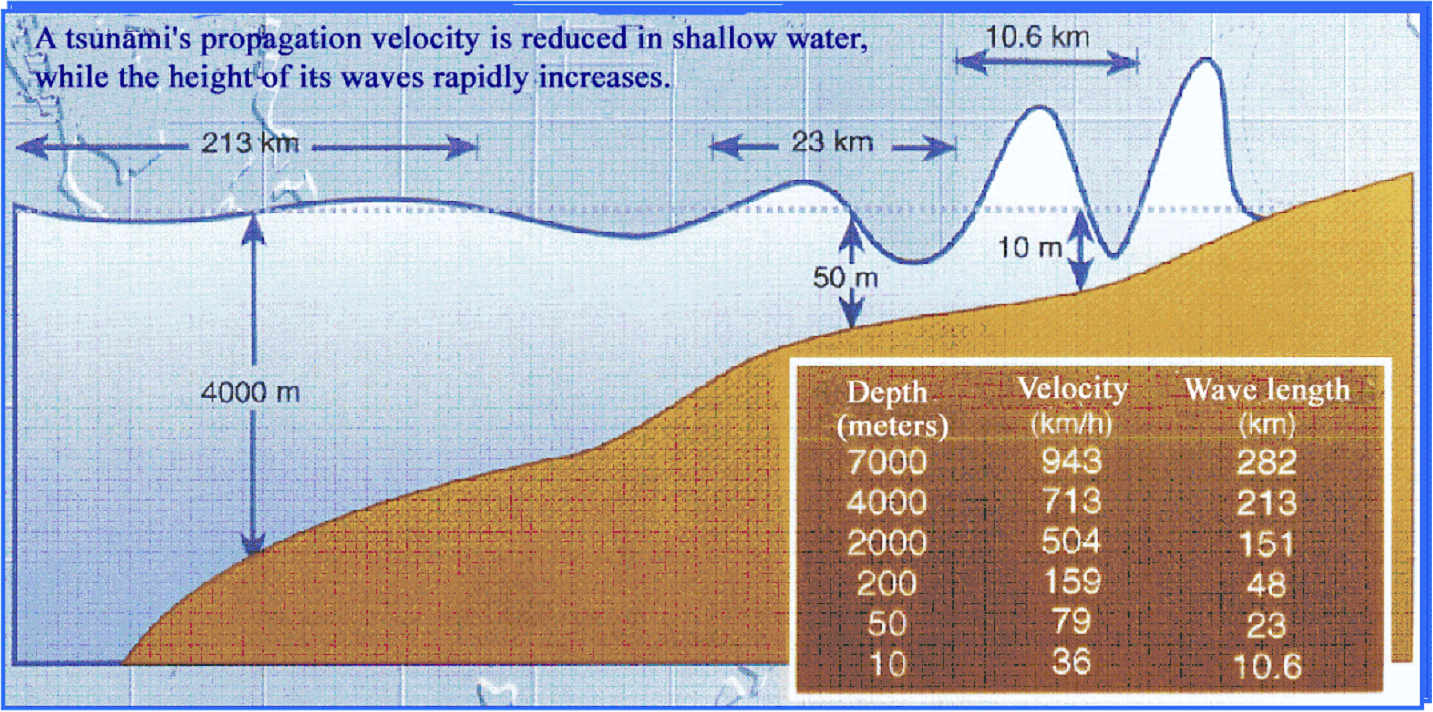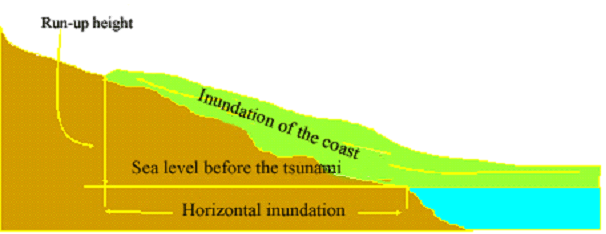SENAT
Report n° 117 (2007-2008) by M. Roland COURTEAU, Senator (for the parliament office for the evaluation of scientific and technological choices) - Appendix to the minutes of the 7 December 2007 session
Disponible au format Acrobat (21 Moctets)
b) A description of the tsunami phenomenon
Following an earthquake, a landslide or a volcanic eruption, the oceanic layer is disrupted, with an uplift and, sometimes, a subsidence of up to several metres. The water surface, acted upon by the forces of gravity, begins to oscillate and waves are generated in every direction outward from the source of origin.
The propagation of a tsunami

Source: CEA
In deep water, tsunamis move at very fast speeds (between 700 and 900 km/h in depths of between 4,000 and 7,000 metres), with very long wave lengths 4 ( * ) (from 100 to more than 200 km). In comparison, a wind-generated wave has a period of around 10 seconds and a length of some 150 m.
The energy of a tsunami wave forms a moving wall from the surface to the bottom of the sea, even in the deepest of waters. This energy corresponds to a mechanical energy (or total energy) that is the sum of the wave's kinetic energy (velocity) and potential energy (linked to the height of the wave).
Out at sea, the waves' speed is very great; therefore, the kinetic energy is also very great and the potential energy very weak. For this reason - and because the waves' period is very long (between a few minutes and several dozen minutes) - the tsunami waves remain undetected by ships at sea.
However, as the waves near the coast, they are slowed down by the rising sea bottom and a shift occurs between the kinetic energy and the potential energy. The kinetic energy decreases (the wave velocity falls to as low as 36 km/h), while the potential energy increases, with the waves growing in height and provoking a rapid rise of the sea level in harbours and bays or an overflowing of the sea onto the coast: in other words, a tsunami.
c) Various manifestations
When a tsunami arrives on the coast, it can manifest itself in various ways, depending on the sources put in play. For instance, the greater the amount of displaced water, the greater the distance travelled by the tsunami, the greater the number of concerned countries, and the greater the risk of destruction. Scientists distinguish between 3 types of tsunami:
- local tsunamis , which are unobservable over a hundred kilometres and are generally provoked by earthquakes with a magnitude of between 6.5 and 7.5, by landslides and by volcanic eruptions;
- regional tsunamis , which travel a distance of between 100 and 1,000 km and are almost always generated by subduction earthquakes (with the exception of the Santorini eruption of 1650 B.C.);
- tsunamis that are capable of devastating coasts thousands of kilometres from their source of origin are known as teletsunamis and are almost always provoked by subduction earthquakes (with the exception of the Krakatoa eruption of 1883). The most recent teletsunami struck the Indian Ocean on 26 December 2004, but one can also cite the tsunami of 1 November 1755 provoked by an earthquake off the coast of Lisbon and which crossed the Atlantic, as well as the tsunami of 22 May 1960 provoked by an earthquake in Chile and which crossed the entire Pacific Ocean, generating 5-metre-high waves on the Japanese coast 24 hours later.
In addition, tsunamis are affected by the coastal relief. While steep slopes reflect waves, gentle slopes increase their amplitude. Likewise, an island can be protected by its corral reef "breaking" the waves. These "site effects" explain why the Tuamotu archipelago are well protected from tsunamis, while the Marquesas Islands are particularly vulnerable; they also explain why tsunamis often have a greater impact on harbours and estuaries.
What are the concrete manifestations of a tsunami?
First of all, a tsunami can cause the sea to retreat far from the coast, followed by its very rapid rise engendering violent, destructive currents. The water's backward surge is also very destructive, for both lightweight installations and persons who find themselves being "sucked away".
Tsunami waves can be amplified by the coastal relief. This is the case of rivers which penetrate deep inland, forming a narrow gully through which the rushing water creates a tidal bore.
Likewise, in closed spaces such as harbours and bays, the waves will succeed one another at 10- to 20-minute intervals, creating a successive emptying-filling effect, with strong currents and eddies.
The particular vulnerability of harbours explains why several boats were damaged in certain harbours along the French Riviera following the earthquake in Boumerdès, Algeria on 21 May 2003 (although the news media incorrectly reported that the French coasts had escaped unscathed). For example, in the port of Théoule-sur-Mer, a significant, rapid rise in the water level was observed, followed by a retreat which partially "pumped" the harbour dry. In the harbour of Figueirette, the water level dropped some 1.5 meters in all of the basins, with very strong currents entering and leaving the harbour.
Finally, in extreme cases, the tsunami can manifest itself by a series of giant waves capable of reaching heights of up to several dozen metres. Their period (between 20 and 40 minutes) makes them particularly dangerous, because those persons having escaped the first wave often think that the danger has passed and so descend to the shore to observe the damage and aid survivors.
What's more, the largest wave is rarely the first, but rather one of the succeeding waves which, in addition to its own potential energy, recovers the energy of a broken wave that is returning to sea. In Banda Aceh, during the Sumatra tsunami of 2004, the first wave measured between 1.5 and 2 metres in height, while the second reached a height of more than 30 metres at certain points along the coast.
In the general consciousness, tsunamis are dangerous because they are associated with waves several metres high striking the coast and destroying everything in their path. In reality, the destructive force of a tsunami has less to do with the height of its wave (or waves) than with its velocity (30 to 40 km/h) and the quantity of water it is carrying, allowing it to penetrate up to several hundred metres inland over flat terrain without any natural obstacles (up to 5 km in Banda Aceh). While a classic wave, with a period of up to a minute, does not raise the water level for a sufficient amount of time to penetrate very far inland, a tsunami wave results in an increased water level for a period of between 5 and 30 minutes.
Therefore, it is the quantity of water which determines the extent of inundationing and the height of the "run-up", or the rise in the water level above sea level.
Tsunami propagation on the coast

Source: CEA
* 4 Wave length is the distance between two successive crests of a periodic wave.







